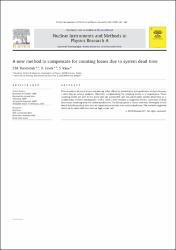| dc.contributor.author | Kaya, Selim | |
| dc.contributor.author | Çevik, Uğur | |
| dc.contributor.author | Karabıdak, Salih Mustafa | |
| dc.date.accessioned | 2019-12-10T11:55:15Z | |
| dc.date.available | 2019-12-10T11:55:15Z | |
| dc.date.issued | 2009-05-21 | |
| dc.identifier.citation | 10.1016/j.nima.2009.02.005 | en_US |
| dc.identifier.issn | 0168-9002 | |
| dc.identifier.uri | https://hdl.handle.net/20.500.12440/1416 | |
| dc.identifier.uri | https://www.sciencedirect.com/science/article/pii/S0168900209003453 | |
| dc.description.abstract | Determination of count losses and pile-up pulse effects in quantitative and qualitative analysis became a vital step in various analyses. Therefore, compensating for counting losses is of importance. These counting losses are due to the pulse pile-up, paralyzable and non-paralyzable system dead time or a combination of these mechanisms. In this work, a new method is suggested for the correction of dead time losses resulting from the above mechanisms. For this purpose, a source code was developed. It was found that the peaking time was an important parameter over system dead time. The method suggested seems to be more effective even at high count rate. | en_US |
| dc.language.iso | eng | en_US |
| dc.publisher | Nuclear Instruments and Methods in Physics Research A | en_US |
| dc.rights | info:eu-repo/semantics/restrictedAccess | en_US |
| dc.subject | Real time ADC conversion time Minimum resolving time Dead time losses | en_US |
| dc.title | A New Method to Compensate for Counting Losses due to System Dead Time | en_US |
| dc.type | article | en_US |
| dc.relation.publicationcategory | Makale - Uluslararası Hakemli Dergi - Kurum Öğretim Elemanı | en_US |
| dc.department | Fakülteler, Mühendislik ve Doğa Bilimleri Fakültesi, Fizik Mühendisliği Bölümü | en_US |
| dc.authorid | 0000-0001-7477-3522 | en_US |
| dc.contributor.institutionauthor | Kaya, Selim | |
| dc.identifier.doi | 10.1016/j.nima.2009.02.005 | |


















